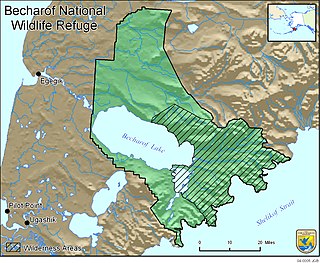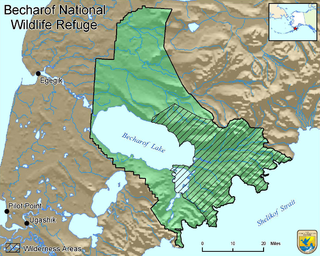
The Arctic National Wildlife Refuge is a national wildlife refuge in northeastern Alaska, United States. It consists of 19,286,722 acres (78,050.59 km2) in the Alaska North Slope region. It is the largest national wildlife refuge in the country, slightly larger than the Yukon Delta National Wildlife Refuge. The refuge is administered from offices in Fairbanks. The Arctic National Wildlife Refuge is the biggest and the wildest land publicly owned by the United States. ANWR includes a large variety of species of plants and animals, such as polar bears, caribou, wolves, eagles, and migratory birds, which rely on the refuge.

Katmai National Park and Preserve is an American national park and preserve in southern Alaska, notable for the Valley of Ten Thousand Smokes and for its brown bears. The park and preserve encompass 4,093,077 acres, which is between the sizes of Connecticut and New Jersey. Most of the national park is a designated wilderness area where all hunting is banned. The park is named after Mount Katmai, its centerpiece stratovolcano. The park is located on the Alaska Peninsula, across from Kodiak Island, with headquarters in nearby King Salmon, about 290 miles (470 km) southwest of Anchorage. The area was first designated a national monument in 1918 to protect the area around the major 1912 volcanic eruption of Novarupta, which formed the Valley of Ten Thousand Smokes, a 40-square-mile (100 km2), 100-to-700-foot-deep pyroclastic flow. The park includes as many as 18 individual volcanoes, seven of which have been active since 1900.

Kodiak Island is a large island on the south coast of the U.S. state of Alaska, separated from the Alaska mainland by the Shelikof Strait. The largest island in the Kodiak Archipelago, Kodiak Island is the second largest island in the United States and the 80th largest island in the world, with an area of 9,311.24 km2 (3,595.09 sq mi), slightly larger than Cyprus. It is 160 km long and in width ranges from 16 to 97 kilometers. Kodiak Island is the namesake for Kodiak Seamount, which lies off the coast at the Aleutian Trench. The largest community on the island is the city of Kodiak, Alaska.

The Alaska Peninsula is a peninsula extending about 800 km (497 mi) to the southwest from the mainland of Alaska and ending in the Aleutian Islands. The peninsula separates the Pacific Ocean from Bristol Bay, an arm of the Bering Sea.

The Kodiak bear, also known as the Kodiak brown bear, sometimes the Alaskan brown bear, inhabits the islands of the Kodiak Archipelago in southwest Alaska. It is the largest recognized subspecies of brown bear, and one of the two largest bears alive today, the other being the polar bear.

Naknek Lake is a lake in southern Alaska, near the base of the Alaska Peninsula. Located in Katmai National Park and Preserve, the lake is 40 miles (64 km) long and three to eight miles wide, the largest lake in the park The lake drains west into Bristol Bay through the Naknek River. The elevation of the lake has lowered over the past 5,000 years as it has cut through a glacial moraine, separating Naknek Lake and Brooks Lake and creating Brooks Falls about 3500 years ago.

The Alagnak River is a 64-mile (103 km) tributary of the Kvichak River in the U.S. state of Alaska. It has a catchment area of approximately 1400 square mi (3600 km2). It is located in central Lake and Peninsula Borough.

Chugach State Park covers 495,204 acres immediately east of the Anchorage Bowl in south-central Alaska. Though primarily in the Municipality of Anchorage, a small portion of the park north of the Eklutna Lake area in the vicinity of Pioneer Peak lies within the Matanuska-Susitna Borough. Established by legislation signed into law on August 6, 1970, by Alaska Governor Keith Miller, this state park was created to provide recreational opportunities, protect the scenic value of the Chugach Mountains and other geographic features, and ensure the safety of the water supply for Anchorage. The park, managed by Alaska State Parks, is the third-largest state park in the United States, and consists of geographically disparate areas each with different attractions and facilities. Only Anza-Borrego Desert State Park in California and Wood-Tikchik State Park in western Alaska are larger. Hunting and fishing are permitted in the Chugach under regulations established by the Alaska Department of Fish and Game for game management unit 14c. Target practice is not allowed within the park boundaries.

Becharof Wilderness is a wilderness area in the U.S. state of Alaska. Located within the Becharof National Wildlife Refuge, it comprises approximately 500,000 acres (2,000 km²) and is bordered by the Katmai Wilderness on the north. It was designated Wilderness in 1980 by the Alaska National Interest Lands Conservation Act. The region is home to a wide array of wildlife, including brown bears, salmon, caribou, and migratory birds.

Southwest Alaska is a region of the U.S. state of Alaska. The area is not exactly defined by any governmental administrative region(s); nor does it always have a clear geographic boundary.
The wildlife of Alaska is diverse and abundant.

The Brooks River Archaeological District encompasses a large complex of archaeological sites along the banks of the Brooks River in Katmai National Park and Preserve in the U.S. state of Alaska. It includes at least twenty separate settlement sites with documented occupation dates from 2500 BCE to recent (post-contact) history. It was declared a National Historic Landmark in 1993. The site is partly occupied by the Brooks Camp, one of the major visitor areas of the park.
The Susitna Flats State Game Refuge is a game preserve in the U.S. state of Alaska. Each year approximately 10 percent of the waterfowl harvest in the state of Alaska occurs on Susitna Flats, with about 15,000 ducks and over 500 geese taken. Many hunters land float planes on one of the numerous lakes on the flats. Other hunters cross the inlet by boat to enjoy their hunt.

Becharof National Wildlife Refuge is a National Wildlife Refuge in the Aleutian Range of the Alaska Peninsula of southwestern Alaska. It is adjacent to Katmai National Park and Preserve. This national wildlife refuge, which covers an area of 1,200,000 acres (4,900 km2), was established in 1980 to conserve major brown bears, salmon, migratory birds, caribou, marine birds, and mammals and to comply with treaty obligations. It lies primarily in the east-central part of Lake and Peninsula Borough, but extends eastward into the mainland portion of Kodiak Island Borough. The refuge is administered from offices in King Salmon.

The Alaska Peninsula montane taiga ecoregion, in the Taiga and Boreal forests Biome, located in North America and defined by the World Wildlife Fund (WWF) categorization system.

The Alaska Peninsula brown bear or peninsular grizzly is a subspecies of brown bear that lives in the coastal regions of southern Alaska, although according to some sources it is a population of the mainland grizzly bear subspecies, or the Kodiak bear subspecies.

Brooks Falls is a waterfall located within Katmai National Park and Preserve in Alaska. Located on the Brooks River a mile and a half (2.4 km) from Brooks Lake and an equal distance from Naknek Lake, the falls are famous for watching salmon leap over the 6 foot falls to get to their Brooks Lake spawning grounds. Consequently, large populations of brown bears, also called grizzly bears, are attracted to feed on the spawning salmon. Brown bears usually congregate at the falls in July and early September, and many well-known photos of bears have been taken there. Bears in July are the greatest concentrations seen at any year at the falls; up to 25 bears have been seen at one time at Brooks Falls in that month. In September, a smaller number of bears can be seen at the falls to feast on the later salmon runs. July and September are by far the best months for viewing grizzly bears in the Brooks Camp area.

Hallo Bay is a sandy bay located beneath the peaks of the Aleutian Range within Katmai National Park. The bay is famous for its bear viewing, since large numbers of grizzly bears are attracted to feast on the rich sedges along the tidal flats of the bay. Sometimes they are also observed digging up clams in the mud, and fishing for salmon peaks in July. The food in the bay is so abundant that at times as many as five to six large bears can be seen at one time feeding on sedges, salmon or clams. The bears are usually timid around humans but have learned to trust them over the years due to decades of no hunting and the gentle nature of visitors. However, an incident in 2003 cost bear enthusiast Timothy Treadwell his life, not far from Hallo Bay.



















